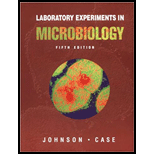
Can aerobic bacteria grow in the absence of
To determine:
If aerobic bacteria can grow in the absence of oxygen andthe method to determine whether bacteria growing on a Petri plate from the brewer jar is anaerobes.
Introduction:
Bacteria is a single-celled microscopic organism that belongs to the prokaryotic domain. They show diversity in their niche and cellular features. Bacteria can survive in aerobic, anaerobic or both conditions (facultative anaerobes). Facultative anaerobes can switch mechanisms to adapt to the environment.
Explanation of Solution
Strict aerobes can only survive in the presence of oxygen, but they can thrive for a short duration in the absence of oxygen too. Some aerobes can switch mechanism to use another terminal electron acceptor instead of oxygen.
Brewer jar is an anaerobic chamber for culturing anaerobes. Atmospheric oxygen is removed from the jar by chemically combining it with hydrogen to release water. The bacteria growing in Petri plates from brewer jar can be tested for anaerobes by subculturing them in aerobic conditions or thioglycolate medium. The subculture of anaerobes would not be able to survive in aerobic conditions whereas thioglycolate broth is a nutrient-rich differential medium used for differentiating aerobic and anaerobic microorganisms. The presence of sodium thioglycolate in the medium allows the growth of obligate anaerobic organisms by consuming the dissolved oxygen. This results in the creation of an anaerobic environment at the bottom of the culture tube. Aerobic organisms thus accumulate at the top of the broth to obtain atmospheric oxygen whereas the obligate anaerobes accumulate at the bottom of the tube where the oxygen is completely absent.
The bacteria growing in Petri plates from brewer jar can be tested for anaerobes by subculturing them in aerobic conditions or thioglycolate medium.
Want to see more full solutions like this?
Chapter 19 Solutions
Symbiosis, Lab Experiments in Microbiology
- Please correct answer and don't used hand raiting and don't used Ai solutionarrow_forward2. In one of the reactions of the citric acid cycle, malate is oxidized to oxaloacetate. When this reaction is considered in isolation, a small amount of malate remains and is not oxidized. The best term to explain this is a. enthalpy b. entropy c. equilibrium d. free energy e. loss of energyarrow_forward18. The citric acid cycle takes place in a. the chloroplasts b. the cytosol c. the inner mitochondrial membrane d. between the two mitochondrial membranes e. the mitochondrial matrix 40 WILarrow_forward
- 8. Most reactions of anaerobic respiration are similar to a. aerobic respiration b. photosynthesis c. lactic acid fermentation d. alcoholic fermentation e. both c and darrow_forward12. Which of the following molecules can absorb light? a. Pigments b. Chlorophyll c. Rhodopsin d. Carotenoids e. All of the abovearrow_forwardWhich of the following proteins or protein complexes is directly required for the targeting of mitochondrial inner membrane multipass proteins, such as metabolite transporters, whose signal sequence is normally not cleaved after import? OA. TIM22 OB. TIM23 C. OXA OD. Mia40 OE SAMarrow_forward
- QUESTION 9 An animal cell has been wounded and has a small rupture in its plasma membrane. Which of the following is more likely to happen next? OA. The cell rapidly cleaves by cytokinesis. OB. The rate of receptor-mediati endocytosis is increased. OC. The rate of exocytosis is increased. OD. The rate of pinocytosis is increased.arrow_forwardFor the a subunit of a trimeric G protein, A. a G-protein-coupled receptor GPCR) acts as a guanine nucleotide exchange factor (GEF), whereas a regulator of G protein signaling (RGS) can act as a GTPase-activating protein (GAP). B. a GPCR acts as a GAP, whereas an RGS can act as a GEF. C. both a GPCR and an RGS can act as a GEF. O D. both a GPCR and an RGS can act as a GAP OE. None of the above.arrow_forwardA cell expresses a transmembrane protein that is cleaved at the plasma membrane to release an extracellular fragment. The fragment binds to receptor proteins on nearby cells and activates signaling pathways resulting in altered gene expression patterns in the cells. What form of intercellular signaling does this represent? OA. Contact-dependent signaling B. Paracrine signaling OC. Synaptic signaling D. Endocrine signaling E. Autocrine signalingarrow_forward
- Which of the following drive nuclearly encoded proteins import into the mitochondrial matrix? OA. ATP hydrolysis OB. Membrane Potential OC. K+ Ions OD. A and B OE. None of the abovearrow_forwardWhich of the following statements is true regarding Cholesterol import into the cell? OA. It is transported within LDL B. Receptor mediated endocytosis is involved OC. Release of cholesterol occurs in the Lysosome D. All of the above are true statements OE. None of the above are true statementsarrow_forwardIn which of the following schematic drawings of signaling pathways does the activation of the receptor lead to gene expression? Activating and inhibitory steps are indicated with (+) and (-), respectively. OA OB ㅇㅂㅇㅂㅇㅁ (+) Gene Expression Activated Signaling proteins Transcription receptor activator Bl D Gene Expression Gene Expression ㅁㅁㅇ Gene Expression Gene Expressionarrow_forward
 Principles Of Radiographic Imaging: An Art And A ...Health & NutritionISBN:9781337711067Author:Richard R. Carlton, Arlene M. Adler, Vesna BalacPublisher:Cengage Learning
Principles Of Radiographic Imaging: An Art And A ...Health & NutritionISBN:9781337711067Author:Richard R. Carlton, Arlene M. Adler, Vesna BalacPublisher:Cengage Learning





